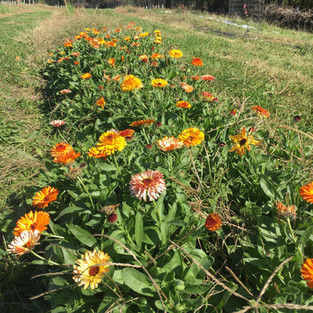What's Planted Where?
- alix462
- Nov 4, 2020
- 3 min read
We have planted the bulk of the trees this year, and they're finishing up dropping their leaves, and settling in for some winter dormancy. Here are some highlights of what we planted, and why.
Remember, we have crop trees in 17 parallel rows going across the slope, and blocks of trees to feed livestock in mini-rows in between. I'll call these crop trees and fodder trees.

The top of the hill is drier and relatively steep. The soils are acidic, in the 5.5 range. So we have planted 30 chestnut trees. They are seedlings of improved varieties, sourced from growers in Ohio and (farther) upstate New York. We have some seedlings whose parent is the "Sleeping Giant" variety from southern Connecticut. This variety is half Chinese chestnut, with some American and Japanese chestnut mixed in. Most of the other varieties are based on Chinese chestnut, which is tolerant of the chestnut blight that wiped out the native American chestnut a century ago. We also have "Peach," which made for some confusing plant labels. (At least there's not also a peach variety called "Chestnut"...). Some of these genetics originated from the University of Missouri's chestnut variety orchard, where they also host an annual chestnut roast. Our version is scheduled for October 2025, when we'll have enough nuts to share with the squirrels and crows, and you.
The orchard in Ohio where our trees originated; the orchard in Missouri that keeps and researches many hardy varieties of chestnut. We are about 25 years behind these projects.
We wanted to take advantage of the acidic soils and grow blueberries, so we have a block of them planted in between crop tree rows. They're right next to Juneberries, which ripen a month or so earlier. These are both native plant species that have been subject to many years of selection and domestication.
Looking down at a blueberry; looking across the (future) wall of plums.
We've got grapes, too! Some vigorous varieties get a tall trellis, and some less-so have a standard trellis with wires around knee level. The trellises fit between rows, so we can eventually have poultry (and possibly sheep!) briefly enclosed in the mini-vineyard. We were able to use T-posts instead of driven wooden posts because we're not trying to hold up hundreds of feet of wire under tension.
In the tree rows by the grapes, we have a series of trees that we plan to "pollard" (i.e., keep cutting back in a sort of lollipop shape). We have willow, black locust, white oak, and white mulberry. This will give us more branches to feed livestock, keep the trees from intercepting too much sun from the grapes (but maybe providing some shade in times of extreme heat), a place for native and beneficial bugs (and their predators) to hang out, and maybe a kind of "natural trellis" to grow grapes on. This last one is an ancient practice that we are testing out, in addition to the more modern, steel-based support systems.
Plums need extra care to get pollinated in the spring. So we've planted them close together, alternating tasty hybrid plums with hardy native American plums to serve as pollenizers. In a few years, their branches will intermingle in a sort of "plum wall" to ensure some pollen moves from tree to tree. Our other efforts to encourage pollinators should help, too.
Moving downhill, we've got elderberries in the wet corner down by the drainage ditch. We have some standard varieties, and one that the University of Missouri recently developed for commercial growers there. They bred it to have such large fruit clusters that they hang upside down, which makes it harder for the birds to intercept a tasty treat. These should start producing the year after next, and show up in a fancy cocktail soon after.
Elderberries are planted near rows of willows that will be coppiced for animal feed, harvested for decorative stems, and managed for early-spring floral resources for bees. We had good success with plastic mulch held down with extra pavers in this especially wet soil.
We tried our hand at growing flowers, too: we had great germination with our calendula, despite seeding it in the heat of summer. It has tolerated a couple of light frosts so far. The bachelor's buttons came up great, but only had time for a couple flowers before the one-two punch of frost and deer.
The big test of how well suited the trees are, will be how they survive the wet period next spring, if they make it past the snows and voles of winter. We're hoping they've had enough time to get established so they can tolerate heavy rains and mud season. We're working on tucking them in now, making sure their tree tubes are sealed with gravel at the bottom, and the deer cages are staked down.

















Comments